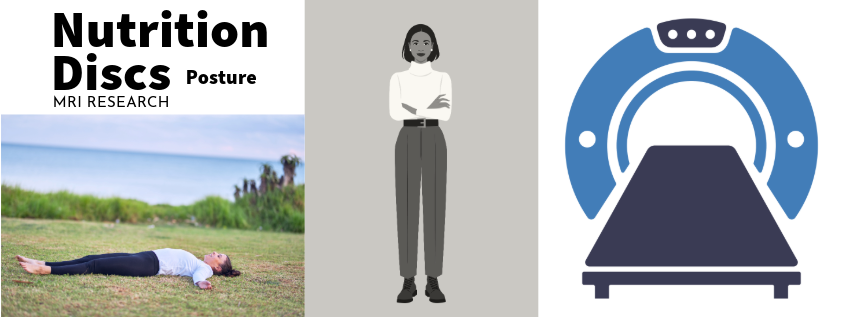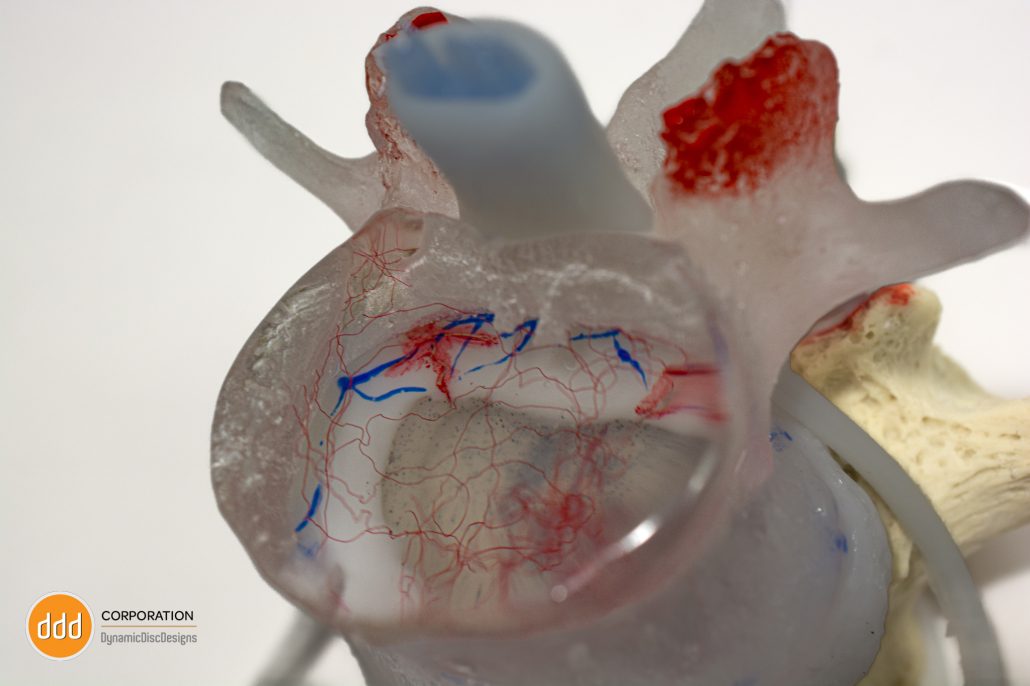
A March, 2024 German MRI study of 20 volunteers with (collectively) 100 healthy intervertebral discs (IVD) demonstrated the influence of three postural positions—supine, standing, and post-standing recovery supine—on the efficacy of nutrient transportation through disc endplates.[1.ISSLS prize in clinical/bioengineering science 2024: How standing and supine positions influence nutrient transport in human lumbar discs?—A serial post‑contrast MRI study evaluating interplay between convection and diffusion] The findings of the novel study provide new insight into the correlation between nutritional disc health and posture.
The Study
Researchers evaluated 100 lumbar disc segments of 20 healthy volunteers—half male, half female— between the ages of 20-30. The participants were healthy and had no history of back issues. They were asked not to perform strenuous tasks during the full 24-hour period (8 am to 8 am) of testing and were screened in each of the three positions using pre-and post-contrast MRIs. Their baseline intervertebral disc nutrition via diffusion was first measured in the supine position. Disc nutritional transport was then evaluated in the subjects as they were imaged in the standing position. Finally, the effects on disc nutrition as the subjects transitioned from standing to recovery supine position were measured immediately after, and no time was allowed to lapse between each positional interval.
The Results
Researchers noted a gradual increase in the enhancement percentage (EP) of the central nucleus pulposus (CNP) in subjects being evaluated in the supine position. This increase peaked at six hours and remained relatively stable through the 12-hour mark, after which, there was a gradual decline. The implication of this finding appears to suggest that nutrients accumulate gradually in the CNP before peaking and diminishing over time.
The subjects underwent standing MRIs immediately following their supine examinations. The resulting data showed a dramatic drop at each time point (2, 6, and 12 hours) in EP levels, compared to those seen in the supine position studies, while there was an 82 percent increase in EP with standing at 24 hours. This occurred within the nucleus pulposus at both the Sup-PNP and the Inf-PNP, though the Sup-PNP had less of a percentage than the Inf-PNP, with a mean difference of EP loss of 78.8 percent. Conversely, the endplate zone (EPZ) of each IVD demonstrated increased enhancement at the same interval.
While the standing imaging showed a sharp drop in EP following supine imaging, recovery supine position scans demonstrated a significant recovery of enhancement, especially in the peripheral nucleus pulposus (PNP), with an average enhancement of 920 percent. Regional differences in the NP were also observed, with a typical enhancement recovery of 104 percent at the CNP.
Though the standing position showed rapid increase in the EP of the EPZ and significant diffusion from CNP to the EP, the previously gained enhancement was mostly lost while in the recovery supine position, with an average loss of 901.2 percent compared to standing. At the same time, the PNP recovered by 920 percent, and the CNP recovered at 104 percent. This suggests a contrasting correlation between the nutrient absorption efficacy of the EP and CNP. In fact, while the nucleus pulposus lost enhancement during standing, its recovery enhancement rate was even greater than the original baseline supine position. Each time the nucleus pulposus lost enhancement in standing and supine positions, the endplate zone gained enhancement and vice versa.

Thoughts
This is the first published clinical study of load-dependent convection and passive diffusion as they relate to the transport of solutes throughout the disc during human standing and resting supine positions. While small molecules typically use diffusion as their method of transport, larger molecules, including hormones and enzymes, use convection, relying on loading and unloading movement to push fluids and nutrients in and out of the discs. Typically, between 3-10 percent of disc fluids are expelled throughout the regular daily loading cycle. This loss is compensated for during overnight sleep, when pressure is relieved on the discs, and there is an influx of fluids.
Most disc deformations occur as daily disc compression impedes adequate nutrient delivery due to decreased fluid content. Periods of sustained static compression negatively affect the removal of metabolic wastes and nutrient diffusion. The effects of positional loading and rest on disc nutrition have not been adequately studied in humans. Further research on this topic could offer valuable insight and assist in future diagnostic and treatment approaches to mitigate mechanical disc stress and nutrient depletion in patients.
Dynamic Disc Designs showcases translatable and instructional research for spine clinicians to share with low back pain patients. A dynamic disc model can be helpful in this case to demonstrate how being supine can be a beneficial strategy in the short term to increase nutrient transport into the disc.
Share Now